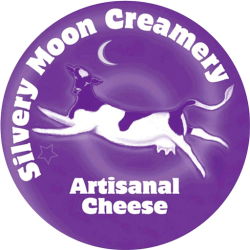All the photos in this section are courtesy of Russell French copyright 2004. They were taken as part of a project Russell French Photography and Nancy Montgomery Designs did for the Maine Cheese Guild back in 2004. Thanks so much to both of them, and for graciously allowing us to use the pictures from the guild shoot on our site as well.
Pasteurizing: Step 1
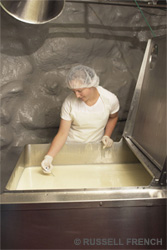
We start with raw milk and gently pasteurize it in our cheese vat. By batch pasteurizing we are able to pasteurize at a lower temperature for a longer period of time. We feel this helps us produce a more unique and flavorful cheese, and protects the integrity of the milk.
Culturing: Step 2
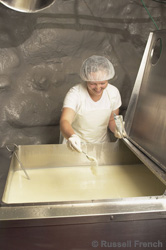
After pasteurizing we cool the milk to somewhere between 85 and 100°F. This temperature varies depending on the type of cheese we are making. We add the cheese culture and allow the milk to rest for an hour or so. We call this ripening. The microbes in the culture acidify the milk, by consuming the milk sugar (lactose) and producing lactic acid.
Renneting: Step 3

Next we add the rennet. Rennet is an enzyme that works with the help of the acidic environment to coagulate the milk. Traditionally, rennet is derived from the lining of a calf's stomach, but we use vegetarian rennet for all of our cheeses. The vegetarian rennet is basically the same enzyme, but it is naturally produced by a yeast (non-GMO).
Cutting the curd: Step 4
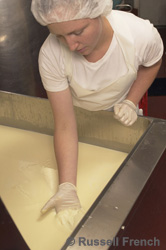
Once the milk is coagulated we are ready to cut the curd. At this point it looks like we have a vat full of yogurt. We first check the firmness of the coagulated milk. We use cheese knives (also called "harps" because they have strings like a harp) to cut the curd into even cubes. We start to see whey accumulate around the curds.
Now we have Miss Muffet's famous curds and whey.
The rest of the steps in the cheesemaking process depend on which type of cheese we are making. For a soft cheese we may ladle the curd out of the vat and into molds to drain. For a hard cheese we slowly heat the curds and whey to facilitate removal of even more whey.
Cheddaring: Step 5
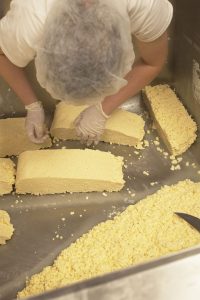 After cooking the curds we then drain off the whey and in the case of cheddar allow the curds to matt together and then cut this mass of curds into slabs for cheddaring. We turn the cheddar slabs every 10 minutes keeping an eye on our increasing acidity and changing texture.
After cooking the curds we then drain off the whey and in the case of cheddar allow the curds to matt together and then cut this mass of curds into slabs for cheddaring. We turn the cheddar slabs every 10 minutes keeping an eye on our increasing acidity and changing texture.
Milling: Step 6
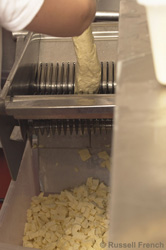
Once the slabs have the right acidity and texture, we mill them into smaller curds and mix in coarse salt.
Molding: Step 7
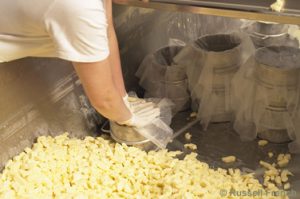 Now the curd is ready to be eaten as fresh curd. We offer our Fresh Cheddar Curd at the Smiling Hill Farm store “fresh from the vat” on Monday afternoons. While they are still warm they squeak as you bite into them. For cheddar wheels, the curd is put into cheese molds lined with cheesecloth and pressed into wheels.
Now the curd is ready to be eaten as fresh curd. We offer our Fresh Cheddar Curd at the Smiling Hill Farm store “fresh from the vat” on Monday afternoons. While they are still warm they squeak as you bite into them. For cheddar wheels, the curd is put into cheese molds lined with cheesecloth and pressed into wheels.
Aging: Step 8
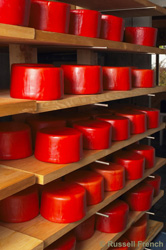
The wheels are aged in our cave at a certain temperature on raw wooden boards. We flip them every week to ensure even distribution of moisture in the cheese. During the aging process some of our cheeses are washed to encourage certain types of rind-developing microorganisms. This washing process adds to the flavor of the cheese, depending on the wash (salty brine, beer, mead, etc.)
